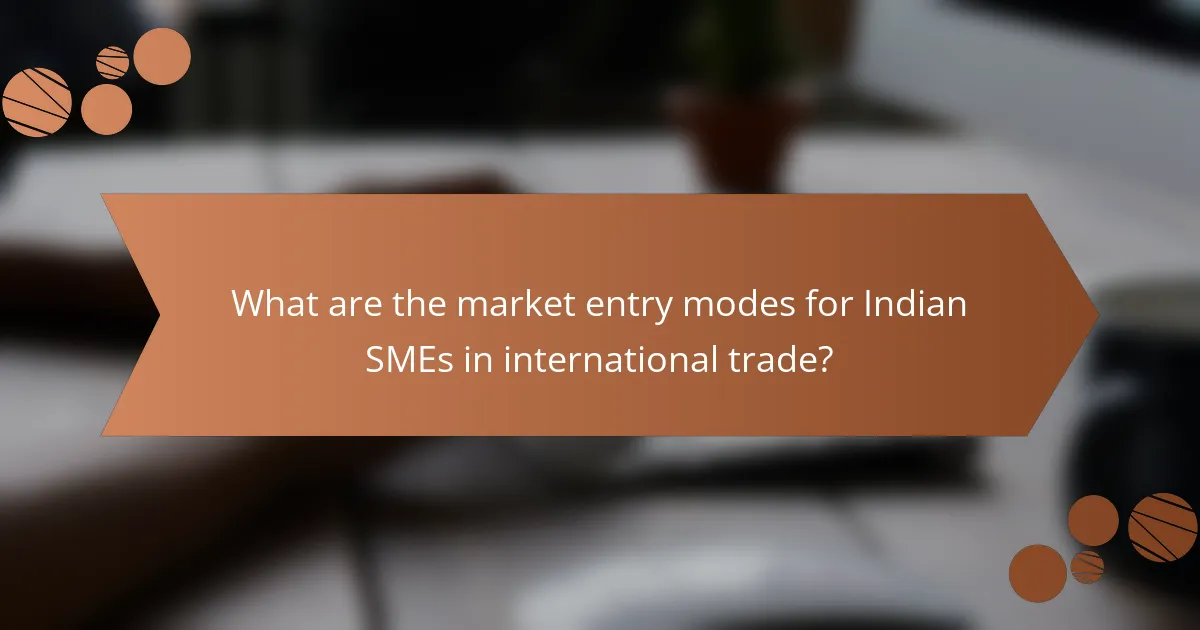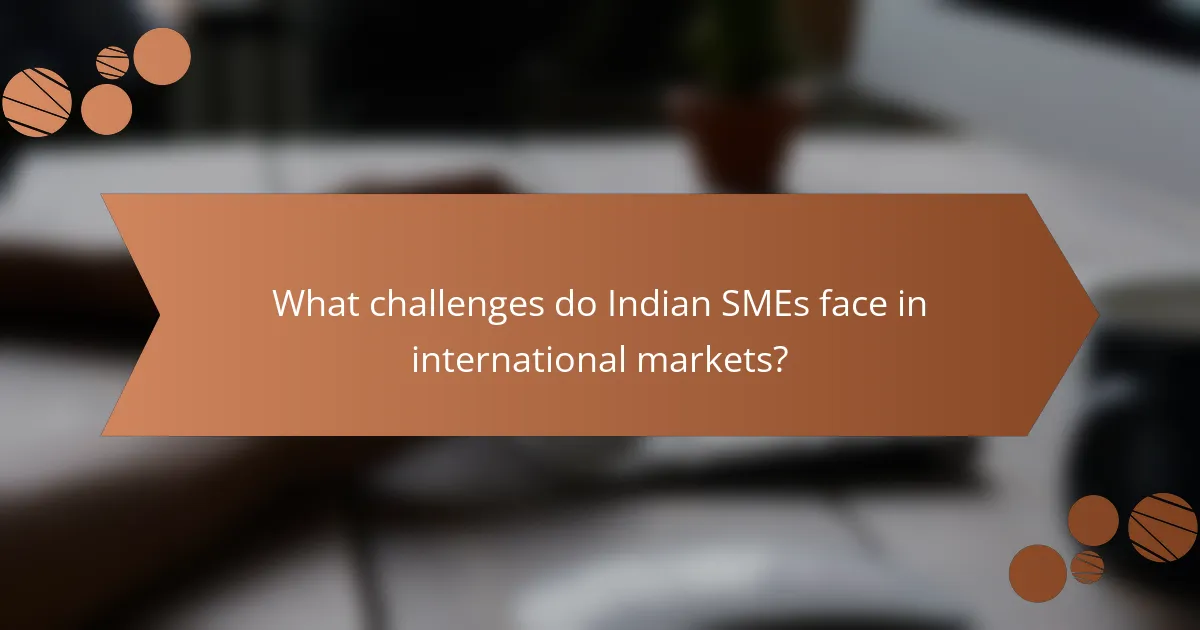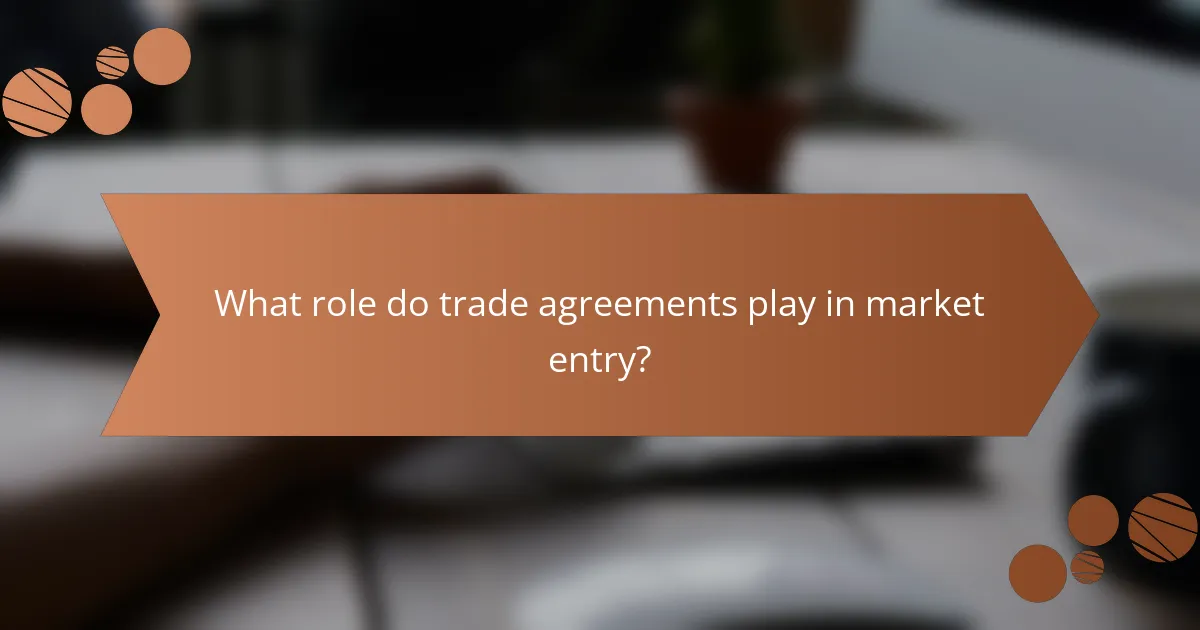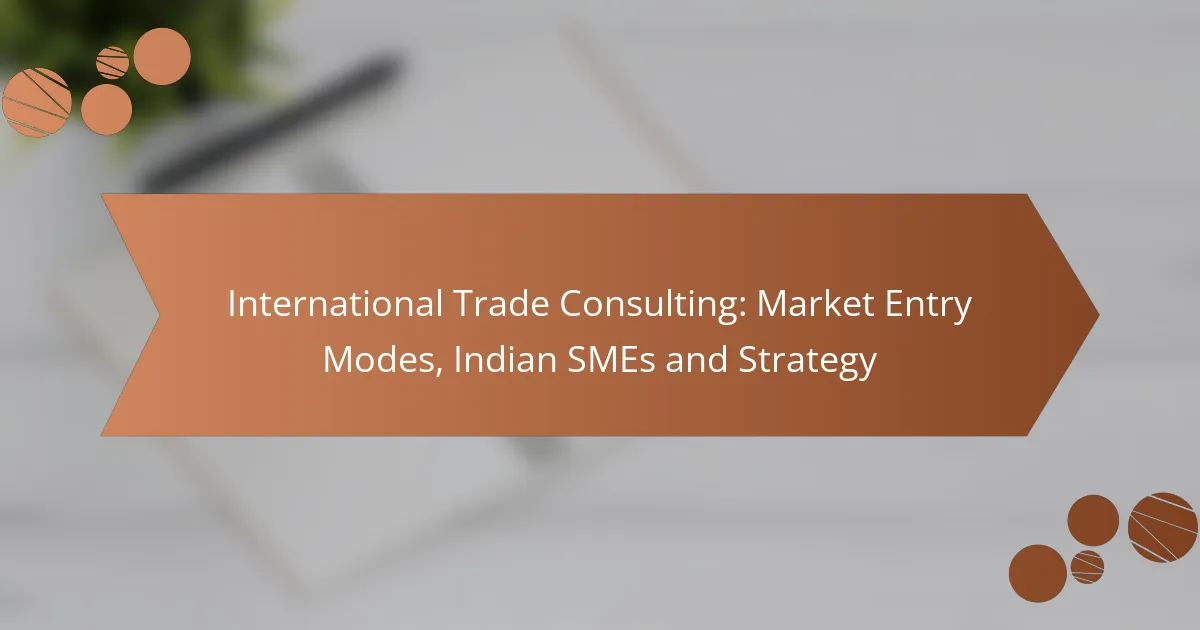International trade consulting provides Indian SMEs with essential strategies for entering global markets, including exporting, joint ventures, and franchising. By assessing their goals and resources alongside the characteristics of target markets, these businesses can select the most effective market entry mode. Expert guidance helps minimize risks and enhances competitiveness, paving the way for successful international expansion.

What are the market entry modes for Indian SMEs in international trade?
Indian SMEs can enter international markets through various modes, including exporting, joint ventures, franchising, licensing, and foreign direct investment. Each mode has distinct advantages and challenges, allowing businesses to choose the most suitable approach based on their resources and market goals.
Exporting
Exporting is the most common market entry mode for Indian SMEs, involving the sale of goods or services to foreign markets. This method allows businesses to test international waters with relatively low risk and investment.
When exporting, SMEs should consider logistics, tariffs, and compliance with international trade regulations. Establishing relationships with local distributors can also enhance market penetration.
Joint ventures
Joint ventures involve partnering with a foreign company to share resources, risks, and profits. This mode can provide SMEs with local market knowledge and established distribution networks.
However, joint ventures require careful selection of partners and clear agreements on roles and responsibilities. Cultural differences and management styles can also pose challenges in these collaborations.
Franchising
Franchising allows Indian SMEs to expand internationally by granting rights to foreign entities to operate under their brand. This model can be particularly effective in sectors like retail and food services.
Franchisors must ensure that their brand standards are maintained and provide adequate training and support to franchisees. Legal considerations regarding franchise agreements and local regulations are also crucial.
Licensing
Licensing involves granting permission to a foreign company to produce and sell products using the SME’s intellectual property. This mode can generate revenue with lower investment and risk.
SMEs should carefully negotiate licensing agreements to protect their intellectual property and ensure quality control. Understanding the local market dynamics is essential for successful licensing arrangements.
Foreign direct investment
Foreign direct investment (FDI) entails establishing a physical presence in a foreign market, such as setting up a subsidiary or branch. This mode offers greater control over operations and brand management.
However, FDI requires significant capital investment and a thorough understanding of local laws and market conditions. Indian SMEs should conduct comprehensive market research and feasibility studies before committing to FDI.

How can Indian SMEs choose the right market entry strategy?
Indian SMEs can choose the right market entry strategy by evaluating their goals, resources, and the specific characteristics of the target market. Key factors include market potential, resource availability, and regulatory requirements, which together inform the most suitable approach for successful international expansion.
Assessing market potential
To assess market potential, Indian SMEs should conduct thorough market research to identify demand, competition, and consumer preferences in the target country. This involves analyzing market size, growth rates, and trends that may affect product or service acceptance.
Utilizing tools like SWOT analysis can help SMEs understand their strengths and weaknesses relative to market opportunities and threats. Engaging local partners or consultants can provide valuable insights into market dynamics and consumer behavior.
Evaluating resource availability
Evaluating resource availability is crucial for determining the feasibility of different market entry strategies. SMEs need to consider financial resources, human capital, and technological capabilities to support their international operations.
For instance, if an SME has limited financial resources, it might opt for lower-risk entry modes like exporting or licensing rather than establishing a subsidiary. A clear assessment of available resources can help in selecting a strategy that aligns with the company’s capacity and risk tolerance.
Understanding regulatory requirements
Understanding regulatory requirements is essential for compliance and successful market entry. Indian SMEs must familiarize themselves with the legal and regulatory landscape of the target market, including import/export regulations, taxation, and labor laws.
Consulting with legal experts or trade associations can provide guidance on navigating these regulations. Additionally, SMEs should be aware of any trade agreements that may facilitate easier access to certain markets, potentially reducing tariffs and other barriers.

What are the benefits of international trade consulting for Indian SMEs?
International trade consulting offers Indian SMEs valuable guidance to navigate global markets, enhancing their competitiveness and growth potential. By leveraging expert insights and tailored strategies, these businesses can effectively enter new markets and minimize risks associated with international expansion.
Expert market insights
Consultants provide Indian SMEs with in-depth market analysis, identifying trends, consumer preferences, and competitive landscapes. This knowledge helps businesses understand the nuances of foreign markets, allowing them to make informed decisions about where and how to expand.
For instance, a consulting firm may analyze demand for a specific product in Southeast Asia, revealing opportunities that SMEs might overlook. Such insights can significantly influence product development and marketing strategies, ensuring alignment with local expectations.
Risk mitigation strategies
International trade involves various risks, including regulatory challenges, currency fluctuations, and cultural differences. Trade consultants assist Indian SMEs in identifying these risks and developing strategies to mitigate them effectively.
For example, a consultant might recommend hedging against currency risks or ensuring compliance with local regulations to avoid costly penalties. By proactively addressing potential issues, SMEs can safeguard their investments and enhance their chances of success in foreign markets.
Customized market entry plans
Every market is unique, and a one-size-fits-all approach rarely succeeds. International trade consultants work with Indian SMEs to create customized market entry plans tailored to specific goals and resources.
This process might include selecting the right entry mode, such as joint ventures, franchising, or direct exports, based on the SME’s capabilities and market conditions. By developing a strategic plan, businesses can optimize their resources and increase the likelihood of a successful market entry.

What challenges do Indian SMEs face in international markets?
Indian SMEs encounter several challenges when entering international markets, including cultural differences, compliance with regulations, and access to financing. These obstacles can hinder their ability to compete effectively and establish a foothold abroad.
Cultural differences
Cultural differences can significantly impact how Indian SMEs operate in international markets. Understanding local customs, consumer behavior, and communication styles is crucial for successful engagement. For example, marketing strategies that work in India may not resonate with audiences in Europe or North America.
To navigate cultural differences, SMEs should invest in market research and consider partnering with local experts. This approach can help them tailor their products and marketing strategies to align with local preferences and expectations.
Compliance with international regulations
Compliance with international regulations is a major hurdle for Indian SMEs looking to expand globally. Different countries have varying laws regarding trade, tariffs, and product standards, which can complicate market entry. For instance, the European Union has strict regulations on product safety and environmental standards that SMEs must adhere to.
To ensure compliance, SMEs should familiarize themselves with the regulatory landscape of their target markets. Consulting with legal experts or trade consultants can provide valuable insights and help avoid costly penalties or delays in market entry.
Access to financing
Access to financing is another critical challenge for Indian SMEs entering international markets. Many small and medium enterprises struggle to secure funding for expansion due to perceived risks by financial institutions. This can limit their ability to invest in necessary resources, such as market research or product adaptation.
To improve access to financing, SMEs should explore various funding options, including government grants, venture capital, and international trade financing programs. Building a solid business plan that outlines potential returns on investment can also help attract investors and lenders.

What role do trade agreements play in market entry?
Trade agreements are crucial for market entry as they establish the rules and conditions for international commerce between countries. They can significantly lower barriers, making it easier for businesses, especially SMEs in India, to access foreign markets.
Reducing tariffs
Trade agreements often include provisions that reduce or eliminate tariffs on goods traded between member countries. Lower tariffs can lead to significant cost savings for exporters, making their products more competitive in the foreign market.
For Indian SMEs, understanding the specific tariff reductions offered by various trade agreements is essential. For instance, the India-ASEAN Free Trade Agreement has reduced tariffs on many goods to zero, which can enhance market entry strategies.
When considering market entry, businesses should evaluate the tariff structures of target countries. A checklist might include: identifying applicable tariffs, assessing the impact of tariff reductions on pricing, and analyzing competitor pricing strategies in the new market.



